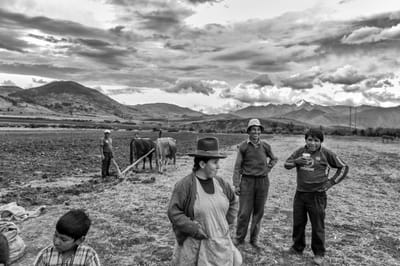THE SUNLESS FLOWERS OF PERU

Il Perù è il terzo e più popolato Paese dell’America del Sud. Qui, circa 600 anni fa, nasceva l’Impero Inca i cui fasti furono travolti dall’arrivo dei conquistadores spagnoli sino alla riconquista dell’indipendenza nel 1824. Tra gli Anni ’70 e ‘90 il Paese sprofonda in un buio periodo di terrorismo che ha visto la morte e la scomparsa di circa 60.000 persone. Dagli antichi splendori di quella che fu una delle più avanzate civiltà precolombiane il Paese è passato all’ottantacinquesima posizione nel Rapporto dell’ONU sullo Sviluppo Umano. E’questo il Perù di oggi. Un Paese dove metà della popolazione si trova in uno stato di completa indigenza e vive soprattutto sugli altipiani dove le strutture educative e sanitarie, nonché le vie di comunicazione, sono pressoché assenti. Un livello di disoccupazione altissimo e strategie politiche che non hanno portato a risultati duraturi. Circa 4 milioni di persone versano, infatti, in condizioni di estrema povertà. Salari scarsi e spesso saltuari che non arrivano a soddisfare i bisogni basilari della famiglia, dove nella maggior parte dei casi lavora solamente il padre e la donna rimane a casa ad accudire i numerosi figli. A queste drammatiche condizioni sociali si somma anche il clima che provocando continui uragani, gelate ed inondazioni, danneggia le produzioni agricole. Nelle zone rurali e sugli altipiani, la maggioranza della popolazione vive di pascolo e di agricoltura, i cui prodotti vengono per lo più destinati all’autoconsumo. Patate, mais e fagioli costituiscono la dieta tipica di questa gente. L’alimentazione si basa spesso su un unico pasto, consumato di solito al mattino, e carente dei principali livelli nutritivi. Le case sono costruite con mattoni di paglia e fango; i tetti sono fatti con lamiera o fieno; alloggi che consistono di un unico ambiente senza pavimentazione, grandi al massimo 4 metri quadrati. Non ci sono servizi igienici e nella maggior parte dei casi non c’è né acqua e né luce. Ogni nucleo familiare è composto in media da sei persone. Con la famiglia vivono spesso anche gli animali domestici. In questo precario stato di cose i bambini sono le vittime principali. Sono denutriti e con una crescita rallentata che, spesso, ne ostacola la capacità di sviluppo cerebrale e di apprendimento. La maggior parte di loro è costretta a contribuire alla gestione familiare diventando venditori ambulanti, lustrascarpe, muratori e minatori. A loro, la famiglia non può garantire un’istruzione. Da un’indagine UNESCO, sulle competenze matematiche e linguistiche dei bambini di scuola primaria delle zone rurali, il Perù occupa gli ultimi posti della classifica Solo il 2% degli studenti riesce a diplomarsi. Sono bambini che sopravvivono in strada, rovistando nella spazzatura; bambini costretti a percorrere infiniti chilometri a piedi per raggiungere una sorgente d’acqua; bambini senza indumenti, senza scarpe e senza sorrisi. Alcuni la sera tornano a casa, per molti altri la loro casa è la strada. Sono bambini senza infanzia...sono come fiori senza sole....
THE SUNLESS FLOWERS OF PERU
Peru is the third and most populated country in South America. Here, about 600 years ago, the Inca Empire was born whose splendor was overwhelmed by the arrival of the Spanish conquistadors until the independence was regained in 1824. Between the Years The 70s and 90s the country sinks into a dark period of terrorism that saw the death and disappearance of about 60,000 people. From the ancient splendours of what was one of the most advanced pre-Columbian civilizations, the country has moved to the eighty-fifth position in the UN Report on Human Development. This is today's Peru. A country where half of the population is in a state of complete poverty and lives above all in the highlands where educational and health facilities, as well as communication routes, are almost absent. A very high level of unemployment and political strategies that have not led to lasting results. In fact, about 4 million people are in extreme poverty. Poor and often occasional salaries that fail to satisfy the basic needs of the family, where in most cases only the father works and the woman stays at home to look after the numerous children. To these dramatic social conditions is also added the climate that causes continuous hurricanes, frosts and floods, damages agricultural production. In rural areas and on the highlands, the majority of the population lives on pasture and agriculture, whose products are mostly destined for self-consumption. Potatoes, corn and beans are the typical diet of these people. The diet is often based on a single meal, usually consumed in the morning, and lacking the main nutritional levels. The houses are built with straw and mud bricks; the roofs are made with sheet metal or hay; accommodations that consist of a single room without flooring, maximum 4 square meters maximum. There are no toilets and in most cases there is neither water nor light. On average, each family consists of six people. Domestic animals often live with the family. In this precarious state of affairs children are the main victims. They are undernourished and with a slowed growth that, often, hinders their capacity of brain development and learning. Most of them are forced to contribute to family management by becoming street vendors, shoe shiners, masons and miners. The family cannot guarantee an education to them. From a UNESCO survey, on the mathematical and linguistic competences of primary school children in rural areas, Peru occupies the last places in the ranking Only 2% of students can graduate. They are children who survive in the street, rummaging through the garbage; children forced to travel endless kilometers on foot to reach a water source; children without clothes, without shoes and without smiles. Some return home in the evening, for many others their home is the street. They are children without childhood ... they are like flowers without sun ....


